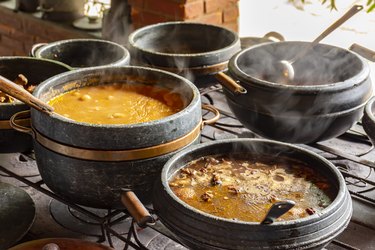
Cookware comes in a lot of different materials and one of the most confusing is "stone." This can refer to stoneware cookware, which is a form of pottery; "stone-finish" nonstick pans; or pots made of actual, honest-to-goodness stone. Some of these are better suited to stove top use than others, so it's important to understand the distinctions before you try to use stoneware on a burner.
Understanding Thermal Shock
Video of the Day
Thermal shock is the reason why some materials don't do well on the stove top. Most materials expand and contract as they heat and cool. If the heating or cooling is too abrupt, the stress can cause cracks, breaks or violent shattering. Even oven-safe items can and will break if they're heated straight from the fridge or set down on a cool surface while hot.
Video of the Day
Because your stove top's burners apply direct, concentrated heat, they are often not suited for use with materials that are prone to thermal shock, according to Pine Springs Pottery. This includes most stoneware and also real stone cookware.
Real Stone Cookware
There are relatively few kinds of cookware made from real stone, mostly consisting of small pots or hybrid pot/serving bowl items such as the Korean dolsot, often used for making bibimbap. These are typically made to be heated slowly over or beside a small fire. Their heavy stone retains heat for a long time, which allows for slow and gentle cooking and, as a bonus, keeps food hot on cold days or through a long and sociable meal.
If you own a dolsot or similar utensil, the manufacturer's site or user's manual will tell you if it can be used on the stove top and whether you'll need a heat-diffusing trivet underneath.
"Stone" Pots and Pans
Some varieties of nonstick pots and pans are sold as having a "stone" finish, to distinguish them from conventional nonstick. These vary in quality as well as the technology and surface used, but are often pitched as being safer or more environmentally friendly than competing products. Because these are designed for stove top use, you can use them on any cooking surface without special precautions.
Stoneware Cookware, Dinnerware and Bakeware
Stoneware cookware is quite different. It's a style of heavy-duty pottery made from dense clay that's fired to a temperature of over 2,000 degrees Fahrenheit during the manufacturing process. This makes it sturdy, durable and very heat-resistant in daily use.
Accordingly, it's used in a wide variety of dinnerware and cooking utensils. Serving plates and trays made of stoneware are usually oven-safe at low to medium temperatures, and stoneware baking dishes and pizza stones can handle just about as much heat as a home oven can generate. The insert of your slow cooker is usually made of stoneware and will work just as well in the oven.
Stoneware on the Stove Top
Despite its heat tolerance, stoneware is chancy on the stove top. For one thing, stoneware can damage flat glass or ceramic stove tops, whether conventional or induction. More importantly, the intense, direct heat of a stove top burner subjects the cookware to more stress than the gentler, indirect heat of the oven.
Most manufacturers caution against using their stoneware on the cooktop, or even under your broiler element, for exactly that reason. A limited number of stoneware pots and dishes can be used on the stove top, but almost invariably they suggest using a heat-diffusing trivet to reduce the risk of damage.
This holds true even for utensils designed to be used that way, such as the North African tagine. Traditionally it would be used at the edge of a small cooking fire, with gentle heat from the bottom. In stove top use, a trivet replicates those conditions and minimizes the risk of thermal shock.